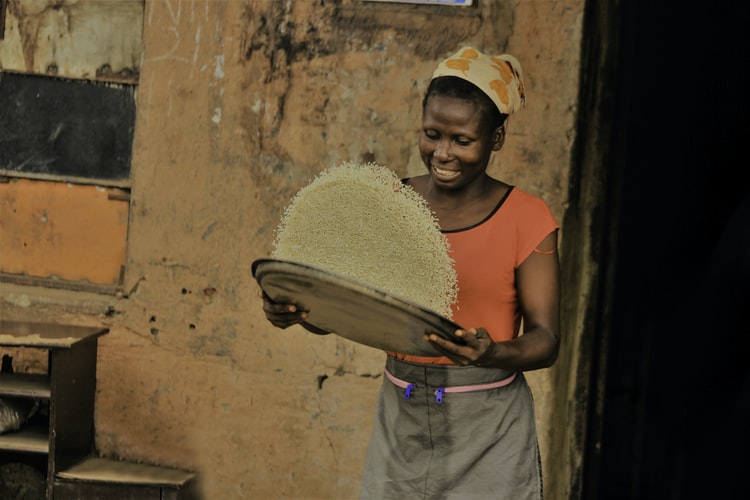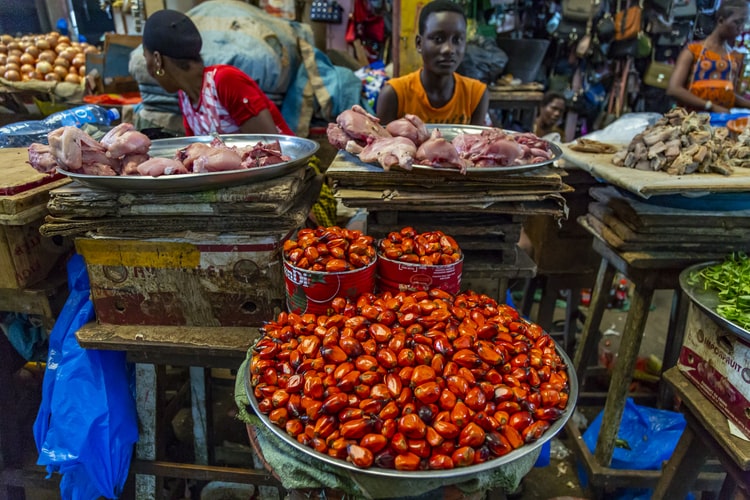Livelihoods are the means by which a person acquires necessities for life. Yet, what a person does for a living is more than a matter of acquiring resources, livelihoods are central to social life and individual identity. This lesson will address the role of livelihoods for people living in Africa.
Lesson Objectives
- define livelihoods
- recognize the relationship between livelihoods and identity as well as social positioning
- describe the role of markets in social systems
- present a livelihood in a selected African country
Livelihoods as a Social Concept

In the Prehistories & Civilizations lesson, we explored the ways that humans developed technological adaptations to the environment such as stone tools and agriculture. These technologies allowed people to manipulate their environment and maximize resources to meet their needs. As people form groups, they create a society, and within a society, humans work together and engage in adaptive strategies as a means of meeting their needs from the environment. Adaptive strategies are organized into livelihoods, and these tasks and duties are carried out according to the positioning of the individual within their society. Social positioning such as gender, age, and kinship oftentimes determines the tasks, duties and obligations of individuals within a community. Livelihoods are frequently linked to individual identity labels such as ‘attorney’, ‘teacher’ or ‘farmer’. As people engage in livelihood activities, they also participate in a system of exchange within their society by contributing resources other people need in exchange for the resources they need. The system of exchange, production, distribution and consumption of resources taking place in a society and between societies is called an economy.
Small Scale Economies

Small scale economic systems are organized by social positioning such as gender, age, kinship, and/or clan. Activities are often based on a system of risk avoidance. In agricultural economies, for example, environmental events such as drought, landslides, early freezes, and/or flooding can incur catastrophic effects on the crops and animals that people rely on for subsistence. To avoid disaster, such as famine from loss of food crops, agriculturalists engage in an age-old strategy to diversify the resource base. What this means is that the farmer will produce multiple different crops to increase security; if an early freeze kills one crop, the family or community will be able to depend on alternate crops that survive. Within small-scale economies, people also rely on social networks to increase security. Social networks increase security by providing people with a safety net to access resources and assistance. Because of this, markets are both economically and socially significant in small-scale societies.
Markets are a social locus for people to interact and engage in exchange relations. Geographically, markets are the nodes that connect villages and communities across vast distances. Throughout Africa and many parts of the world, open-air markets are festive locations where people congregate to buy, sell, and trade as well as interact. The video below depicts Roque Santeiro, the largest market in Angola. Watch the video and consider the ways that markets are both socially and economically significant.
Large-Scale Economies
Large-scale societies are generally characterized by national and international economic exchanges. The lessons included in the Histories Module addressed the ways that early trading routes and colonialism contributed to the development of a large-scale world economic system based on international trade. This economic system is often referred to as a ‘formal’ economy because it is usually taxed, regulated through laws, monitored by government agencies, documented into economic indices such as ‘per capita income’, ‘gross national product’, stock and trading prices, etc.In many cases, formal economies are accompanied with ‘informal’ economic activity. Informal economies are comprised of economics activities that are undocumented. In the United States, this is referred to as ‘working under the table’ and it is illegal. In many poor areas throughout the world, however, informal economies play a key role in meeting the needs of the poor. This is because the formal sector fails to provide adequate wages and resources for people to live. Throughout Africa, formal commercial enterprises are characterized by high unemployment, no labor regulations, flexible (non-contract or temporary) labor agreements. As a result, people must engage in a dual economic system, one that is based on formal and informal economic activities, in order to meet their needs. The video below shows how some women in the Gambia are making objects from recycled plastic bags in order to earn additional income for themselves and their families.
Women and Livelihoods
The Development lesson in this course addressed the wide range of problems and issues related to the globalization of African economies and the resulting challenges of poverty and unemployment in Africa. Like many areas of the world, women represent the poorest population in a society. Given that African countries represent the poorest countries in the world, poor women in Africa represent the poorest population on the planet. In spite of this many women throughout Africa are pursuing new strategies and livelihoods to not only improve their own wellbeing, but to also improve the lives of their families. The slideshow in the short film, ‘Portraits of African Women,’ below presents vignettes of the wide range of livelihoods among both urban and rural women in Africa.
Immigration as Livelihood
Immigration out of Africa to earn income in a foreign country to send home is a growing livelihood strategy in poor nations in Africa. A remittance is a non-commercial transfer of money by a foreign worker, a member of a diaspora community, or a citizen with familial ties abroad, for household income in their home country or homeland. Remittances to Africa play an important role in national economies. However, little data exists as many rely on informal channels to send money home. Immigrants from Africa today number approximately 20 to 30 million adults, who send around US$40 billion annually to their families and local communities back home. For the region as a whole, this represents 50 percent more than net official development assistance (ODA) from all sources, and, for most countries, the amount also exceeds foreign direct investment (FDI). In several fragile states, remittances are estimated to exceed 50 percent of GDP.
Most African countries restrict the payment of remittances to banks, which in turn, typically enter into exclusive arrangements with large money transfer companies, like Western Union or Money Gram, to operate on their behalf. According to a World Bank study, Nigeria is by far the top remittance recipient in Africa, accounting for $10 billion in 2010, a slight increase over the previous year ($9.6 billion). Other top recipients include Sudan ($3.2 billion), Kenya ($1.8 billion), Senegal ($1.2 billion), South Africa ($1.0 billion), Uganda ($0.8 billion), Lesotho ($0.5 billion), Ethiopia ($387 million), Mali ($385 million), and Togo ($302 million). As a share of Gross Domestic Product, the top recipients in 2009 were: Lesotho (25%), Togo (10%), Cape Verde (9%), Guinea-Bissau (9%), Senegal (9%), Gambia (8%), Liberia (6%), Sudan (6%), Nigeria (6%), and Kenya (5%).
The video below shows how African workers in Europe not only support family members and households in Africa with remittances, they can also support emerging entrepreneurs in their home country.
Livelihoods in African Humanities
By exploring the wide variety of unique livelihoods throughout Africa, we can develop an understanding of the many ways that social and historical circumstances shape the wide variety of daily tasks and duties people engage in order to meet their needs. Like language, culture and religion, livelihoods are often rooted in social and cultural systems that are rooted in individual and collective identity.
Questions to Consider for Class Discussion
- In what ways are livelihoods an adaptive strategy to meet needs in Africa?
- What is the relationship between livelihoods and identity as well as in social and cultural systems?
- What role do markets play in society?
- What is an example of a livelihood in your selected African country?
References and Resources
- Cervone, Sarah. 2010. ‘Beneath the Peak: Tourism and the Global Economy in a Moroccan Mountain Community.’ Dissertation, University of Florida.
- Potts, Deborah. 2012. ‘Urban economies, urban livelihoods and natural resource-based economic growth in sub-Saharan Africa: The constraints of a liberalized world economy.’ Local Economy. 2013;28(2):170-187.
- Barbalet, Veronique. 2017. ‘Livelihood Strategies of Central African Refugees in Cameroon‘ HPG Working Paper
- Mapping Africa’s Natural Resources. Aljazeera.
- P. Chabal, U. Engel, and L.J. de Haan. 2007. ‘Studies in African livelihoods : current issues and future prospects‘ African Alternatives. Leiden: Brill.
- ‘70% of Africans make a living through agriculture, and technology could transform their world’ World Economic Forum
- George and Chile. April 2020. ‘Nigeria’s tech experts step in to help those losing livelihoods under lockdown’ Technology News.
- Potts, Deborah. 2012. Urban economies, urban livelihoods and natural resource-based economic growth in sub-Saharan Africa: The constraints of a liberalized world economy. Local Economy: the journal of the local economy policy unit.
For Discussion in Canvas
Research and describe a livelihood practiced in your selected country. What is the resource produced or extracted? How it is exchanged? Are there any social or cultural ways the livelihood is carried out? (ie by women, by the community, etc. ) Is it part of the formal or informal economy? Be sure to cite your sources and reply to another student’s post.
